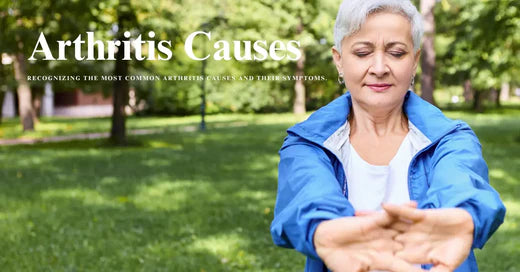
Recognizing The Most Common Arthritis Causes
Share
Arthritis happens when there is inflammation in your joints, but it can also impact other organs like the eyes, heart, or skin. To get the right treatment, one needs the correct diagnosis of the kind of arthritis they have. There are various kinds of arthritis, caused by several reasons, and each type requires a treatment that targets the particular cause responsible for it.
Arthritis has many types based on causes and symptoms; osteoarthritis and rheumatoid arthritis are found more often than others. The below-mentioned arthritis types have been recognized by several professionals based on various arthritis causes.

- The most prevalent kind of arthritis, osteoarthritis, is more prevalent in the elderly. It causes cartilage to wear down.
- The kind of arthritis that inflames the spine's ligaments and joints is called ankylosing spondylitis.
- A form of arthritis that flares up is called gout, which usually affects one's big toe or lower limb. It happens when there is an excess of uric acid in our blood.
- Children who suffer from chronic arthritis quite often have juvenile idiopathic arthritis.
- Those people with psoriasis (scaly red and white skin spots) may also develop psoriatic arthritis. It impacts the joints, skin, and spaces where tissues and bones meet.
- If a person’s body has an infection, it is the source of reactive arthritis. Usually, those symptoms go away on their own in a few weeks or months.
- An autoimmune arthritis called rheumatoid arthritis happens when the body starts targeting the healthy tissues in the joints.
- When germs in the bloodstream cause painful joint infections, it leads to septic arthritis. However, it can also occur because of injuries like deep cuts or stab wounds that could introduce pathogens directly into joints. Since it can cause serious damage to the joints, that's why it requires quick treatment, such as the draining of joints.
- Normally, thumb joints have cartilage cushioning, but when it deteriorates with age or due to accidents, the bones rubbing against each other instead of gliding causes thumb arthritis.
Early symptoms of arthritis
Different people experience different types of symptoms based on the kind of arthritis they have. Some patients have recurring flares, while others feel the pain during physically exerting activities. Some of the most commonly reported symptoms are:
- Joint pain
- stiffness or a diminished range of motion in the affected joint.
- Swelling is indicative of inflammation.
- Alterations in skin coloration.
- Tenderness or heightened sensitivity to touch in the vicinity of the joint.
- A sensation of heat or warmth in the area surrounding the joints.
Arthritis Causes: Who is more susceptible to it?
One can get arthritis at any stage, depending on what the cause is. There are several causes of arthritis, and it determine the type of arthritis one gets. Among those causes, the below-mentioned are the prominent arthritis causes:
- Deterioration of joints’ cartilage cushioning due to its usage.
- Too much uric acid in the bloodstream
- Damage of healthy tissues due to autoimmune system actions on the body
- Some viral infections
- Some arthritis occurs without any triggers and is known as idiopathic arthritis.
Age: The Biggest Cause of Arthritis
With age, our cartilage wears down and impacts the smooth gliding of bones over each other at the joints. That's why a senior citizen has a high possibility of getting arthritis. This is not to say a young adult can’t get arthritis due to some unforeseen circumstances, but the possibility is low compared to the former.
Arthritis Symptoms in Hands and Ankles
Continuous stress on the joints of a certain body part can be one of the causes of arthritis. Inflammation in the joints leads to arthritis. Our hands and ankles, which have many joints, are a common site for arthritis to happen. In our hands, there are four regions that arthritis is attacking:
- the point where your thumb and wrist connect at its base.
- Your knuckles.
- the finger joints in the middle.
- The finger joint on top is closest to your nails.
Some symptoms of arthritis in hands and ankles:
The type of arthritis one has depends on the symptoms you have. Some common symptoms include:
- Swelling in your hand and leg joints
- Pain in the hands, legs, and fingers
- Stiffness in your joints
- Weakness in your hands and legs
The most frequently affected foot joints in cases of arthritis are:
- The joint where the ankle articulates with the shinbone.
- The three joints of the foot involve the calcaneus (heel bone), the navicular (inner midfoot bone), and the cuboid (outer midfoot bone).
- The joint connects the big toe to the first metatarsal bone.
Hands and Ankle Arthritis Treatment:

Initially, the doctor or health practitioner doesn't suggest surgery and recommends other nonsurgical treatment options. Some of these include:
- Some changes in our daily lifestyle can alleviate the pain and even slow down disease progression by reducing strenuous activities or losing weight to minimize the stress on joints.
- Certain exercises can boost your flexibility and range of motion while also strengthening the muscles in your foot and ankle. A doctor or health practitioner can design an exercise routine personalized for you. Sometimes it can aggravate instead of alleviating the pain; in that case, your doctor would make changes accordingly.
- Sometimes people get help with assisting devices like braces and custom-made shoes to minimize foot pressure.
- Some people take nonsteroidal anti-inflammatory drugs or injections into the joints.
If all of these don't work, the doctor might suggest surgical treatment depending on the type and location of arthritis and its impact on your joints. The most effective surgery is arthroscopic surgery, usually done in the early stages of arthritis.
Diagnosis and Treatment of Arthritis
The primary objective of arthritis treatment is to alleviate the symptoms and enhance the quality of life. To get successful results, one needs to get the correct diagnosis through the required tests. Some common tests are:
- X-ray
- Ultrasound
- Magnetic resonance imaging [MRI]
- Computed tomography (CT) scan
- Blood tests
To date, there is no definite cure for arthritis, but an arthritis patient can still live a better life with proper management and treatment procedures catering to the symptoms they are facing. Some of the most commonly applied treatments are anti-inflammatory medicine and physical therapy for better limbic moments, and if these non-surgical treatments aren’t applicable, then surgeries like joint fusion or joint replacement [anthroplasty].
Risk factors and preventive measures for arthritis
Certain risk factors can’t be avoided, like increasing age, gender, and heredity, but other factors like weight, injury, infection, and sitting posture during work hours can be controlled. Arthritis mostly impacts joints at the hands and wrists, knees, hips, feet and ankles, shoulders, and lower back. There are certain preventive measures one can take to reduce the risk or delay its onset:
- Maintain a healthy weight to not put extra pressure on joints.
- Control blood sugar level, as it affects the stiffness of the tissues.
- Strengthen the muscles by exercising.
- Improve the range of motion by stretching daily.
- Avoiding injury to any joint
- Avoiding tobacco as it stresses the tissue
- Take omega-3-containing food items to reduce inflammation.
- Get your doctor’s suggestion for preventive care.
Conclusion :
Arthritis is a prevalent health concern, with osteoarthritis being the most common type. Research indicates that a significant number of adults will experience this condition at some point in their lives. There are several causes of arthritis, including the wear and tear of cartilage, high levels of uric acid in the blood, autoimmune damage to healthy tissues, certain viral infections, and idiopathic arthritis, which occurs without identifiable triggers. Although it's not considered curable, one can still live a good life with proper management and treatment. To address this matter, it is essential to consult with your physician or a qualified healthcare practitioner to obtain an accurate diagnosis of the specific type of arthritis you are experiencing, as well as the appropriate treatment required.
Frequently Asked Questions:
Why does arthritis occur?
Arthritis can develop at any age, and there are multiple causes of arthritis, based on which the type of arthritis is determined. The most common factor is age; with increasing age, the possibility of getting arthritis increases. There are other causes of arthritis, such as injury, auto-immune damage, viral infections, etc.
What are the main causes of arthritis?
The main causes of arthritis include deterioration of cartilage joints, high levels of uric acid in the blood, autoimmune damage to healthy tissue, certain viral infections, and idiopathic arthritis, which occurs without identifiable triggers.
Does weather affect arthritis patients?
Extreme weather conditions can trigger joint pains. Some feel pain in their joints during the winter season, while others feel hot and humid weather makes them feel worse. It varies from person to person.
Which food items are bad for arthritis?
Certain food items that are advised to be avoided by arthritis patients are high-fat dairy products, sugary beverages, red meat, fried and canned food, etc.
